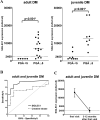SIGLEC1 enables straightforward assessment of type I interferon activity in idiopathic inflammatory myopathies
- PMID: 35177553
- PMCID: PMC8860073
- DOI: 10.1136/rmdopen-2021-001934
SIGLEC1 enables straightforward assessment of type I interferon activity in idiopathic inflammatory myopathies
Abstract
Objective: To evaluate sialic acid binding Ig-like lectin 1 (SIGLEC1) expression on monocytes by flow cytometry as a type I interferon biomarker in idiopathic inflammatory myopathies (IIM).
Methods: We performed a retrospective analysis of adult and paediatric patients with the diagnosis of IIM. SIGLEC1 expression was assessed by flow cytometry and was compared with Physician Global Assessment or Childhood Myositis Assessment Scale disease activity scores. Mann Whitney U test and receiver operating characteristic curves were used for cross-sectional data analysis (n=96), two-level mixed-effects linear regression model for longitudinal analyses (n=26, 110 visits). Response to treatment was analysed in 14 patients within 12 months, using Wilcoxon test. SIGLEC1 was compared with interferon-stimulated gene 15/MxA status by immunohistochemical staining of muscle biopsies (n=17).
Results: 96 patients with adult (a) and juvenile (j) dermatomyositis (DM, n=38), antisynthetase syndrome (AS, n=19), immune-mediated necrotising myopathy (IMNM, n=8), inclusion body myositis (IBM, n=9) and overlap myositis (n=22) were included. SIGLEC1 distinguished significantly between active and inactive disease with an area under the curve of 0.92 (95% CI 0.83 to 1) in DM and correlated with disease activity longitudinally (aDM: standardised beta=0.54, p<0.001; jDM: standardised beta=-0.70, p<0.001). Response to treatment in DM was associated with a decreasing SIGLEC1 (p<0.01, Wilcoxon test). SIGLEC1 was found upregulated in 8 of 19 patients with AS, 2 of 9 patients with IBM but not in IMNM.
Conclusion: SIGLEC1 is a candidate biomarker to assess type I interferon activity in IIM and proved useful for monitoring disease activity and response to treatment in juvenile and adult DM.
Keywords: autoantibodies; autoimmunity; dermatomyositis; polymyositis.
© Author(s) (or their employer(s)) 2022. Re-use permitted under CC BY-NC. No commercial re-use. See rights and permissions. Published by BMJ.
Conflict of interest statement
Competing interests: None declared.
Figures





Similar articles
-
Type I interferon biomarker in idiopathic inflammatory myopathies: associations of Siglec-1 with disease activity and treatment response.Rheumatology (Oxford). 2025 May 1;64(5):2979-2986. doi: 10.1093/rheumatology/keae630. Rheumatology (Oxford). 2025. PMID: 39563518 Free PMC article.
-
Myostatin in idiopathic inflammatory myopathies: Serum assessment and disease activity.Neuropathol Appl Neurobiol. 2023 Feb;49(1):e12849. doi: 10.1111/nan.12849. Epub 2022 Oct 7. Neuropathol Appl Neurobiol. 2023. PMID: 36168256 Free PMC article.
-
Classification of idiopathic inflammatory myopathies: pathology perspectives.Curr Opin Neurol. 2019 Oct;32(5):704-714. doi: 10.1097/WCO.0000000000000740. Curr Opin Neurol. 2019. PMID: 31369423 Review.
-
Where are we moving in the classification of idiopathic inflammatory myopathies?Curr Opin Neurol. 2020 Oct;33(5):590-603. doi: 10.1097/WCO.0000000000000855. Curr Opin Neurol. 2020. PMID: 32852298 Review.
-
Nailfold videocapillaroscopy alterations in dermatomyositis, antisynthetase syndrome, overlap myositis, and immune-mediated necrotizing myopathy.Clin Rheumatol. 2019 Dec;38(12):3451-3458. doi: 10.1007/s10067-019-04710-2. Epub 2019 Aug 22. Clin Rheumatol. 2019. PMID: 31440919
Cited by
-
Peripheral immune landscape for hypercytokinemia in myasthenic crisis utilizing single-cell transcriptomics.J Transl Med. 2023 Aug 24;21(1):564. doi: 10.1186/s12967-023-04421-y. J Transl Med. 2023. PMID: 37620910 Free PMC article.
-
Type I interferon biomarker in idiopathic inflammatory myopathies: associations of Siglec-1 with disease activity and treatment response.Rheumatology (Oxford). 2025 May 1;64(5):2979-2986. doi: 10.1093/rheumatology/keae630. Rheumatology (Oxford). 2025. PMID: 39563518 Free PMC article.
-
SIGLEC-1 in Systemic Sclerosis: A Useful Biomarker for Differential Diagnosis.Pharmaceuticals (Basel). 2022 Sep 28;15(10):1198. doi: 10.3390/ph15101198. Pharmaceuticals (Basel). 2022. PMID: 36297311 Free PMC article.
-
Exploring CD169+ Macrophages as Key Targets for Vaccination and Therapeutic Interventions.Vaccines (Basel). 2025 Mar 20;13(3):330. doi: 10.3390/vaccines13030330. Vaccines (Basel). 2025. PMID: 40266235 Free PMC article. Review.
-
SIGLEC1 has the potential to be an immune-related prognostic indicator in colon adenocarcinoma: a study based on transcriptomic data and Mendelian randomization analysis.Discov Oncol. 2025 Mar 15;16(1):324. doi: 10.1007/s12672-025-02093-2. Discov Oncol. 2025. PMID: 40088346 Free PMC article.
References
-
- Lundberg IE, Tjärnlund A, Bottai M, et al. . 2017 European League against Rheumatism/American College of rheumatology classification criteria for adult and juvenile idiopathic inflammatory myopathies and their major subgroups. Ann Rheum Dis 2017;76:1955–64. 10.1136/annrheumdis-2017-211468 - DOI - PMC - PubMed
Publication types
MeSH terms
Substances
LinkOut - more resources
Full Text Sources
Other Literature Sources
Medical
Research Materials
